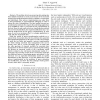Free Online Productivity Tools
i2Speak
i2Symbol
i2OCR
iTex2Img
iWeb2Print
iWeb2Shot
i2Type
iPdf2Split
iPdf2Merge
i2Bopomofo
i2Arabic
i2Style
i2Image
i2PDF
iLatex2Rtf
Sci2ools
108
click to vote
ICDE
2008
IEEE
2008
IEEE
On Unifying Privacy and Uncertain Data Models
The problem of privacy-preserving data mining has been studied extensively in recent years because of the increased amount of personal information which is available to corporations and individuals. Most privacy transformations use some form of data perturbation or representational ambiguity in order to reduce the risk of identification. The final results from privacy transformation methods often require the underlying applications to be modified in order to work with the new representation of the data. Since the end results of privacy-transformation methods have not been standardized, the required modifications may vary with the method used for the privacy transformation. In some cases, it can be an enormous effort to re-design applications to work with the anonymized data. While the results of privacy-transformation methods are a natural form of uncertain data, the two problems have generally been studied independently. In this paper, we make a first attempt to unify the two fields, ...
Database | ICDE 2008 | Privacy Transformation | Privacy Transformation Methods | Uncertain Data Management |
| Added | 01 Nov 2009 |
| Updated | 01 Nov 2009 |
| Type | Conference |
| Year | 2008 |
| Where | ICDE |
| Authors | Charu C. Aggarwal |
Comments (0)

